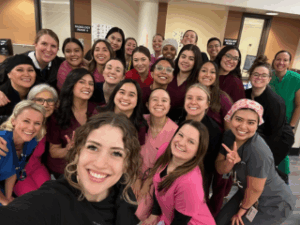 The focus on autism over the past few years has intensified due to more research being conducted that is leading to a greater understanding of the disorder. Health care professionals, from doctors to medical assistants, are learning about many new therapies and medications that are being explored to help individuals and families manage autism. The prevalence of autism is growing in the U.S. According to the Autism Society, approximately 1 percent of children in the United States ages 3 to 17 have an autism spectrum disorder (ASD). 1 ASD is a developmental disorder that affects how social and communication skills are developed.2 According to Autism Speaks, an organization of advocates who are devoted to securing funding to research the causes of, treatments for and prevention of autism, there are currently no effective ways to test for the disorder. Rather, physicians and psychologists administer tests to determine if a child has the disorder. Oftentimes parents are the first ones to notice their child is behaving differently. Some signs include not making eye contact or having problems communicating. In the past many doctors were unfamiliar with diagnosing the child’s symptoms as signs of autism. Autism Speaks and other advocacy organizations are working to emphasize the importance of educating students on the signs and treatments for autism so they can help parents manage the disorder better.2
The focus on autism over the past few years has intensified due to more research being conducted that is leading to a greater understanding of the disorder. Health care professionals, from doctors to medical assistants, are learning about many new therapies and medications that are being explored to help individuals and families manage autism. The prevalence of autism is growing in the U.S. According to the Autism Society, approximately 1 percent of children in the United States ages 3 to 17 have an autism spectrum disorder (ASD). 1 ASD is a developmental disorder that affects how social and communication skills are developed.2 According to Autism Speaks, an organization of advocates who are devoted to securing funding to research the causes of, treatments for and prevention of autism, there are currently no effective ways to test for the disorder. Rather, physicians and psychologists administer tests to determine if a child has the disorder. Oftentimes parents are the first ones to notice their child is behaving differently. Some signs include not making eye contact or having problems communicating. In the past many doctors were unfamiliar with diagnosing the child’s symptoms as signs of autism. Autism Speaks and other advocacy organizations are working to emphasize the importance of educating students on the signs and treatments for autism so they can help parents manage the disorder better.2
Alternative treatments for autism are being explored
Different factors have contributed to the increase in reports of individuals living with autism. Greater awareness of the disorder and better access to services to treat and manage it has led to more medical students and professionals contributing to the research on autism. Knowledge of how environmental factors affect development in children and how some can be the cause of autism has helped professionals in their research.2 The most common forms of treatment for autism are behavior therapy and prescription medications. However, more and more alternative treatments are being researched to determine if they can help children who have this disorder gain control of their symptoms. Researchers who are studying these alternatives found that about 40 percent of children with autism were using alternative treatments, including special diets and nutritional supplements. Gluten-free and casein-free diets were among the therapies being used for children. However, these treatments were used in conjunction with behavioral and educational services.3 The efficacy of alternative treatments for autism is a relatively new topic that is being studied and therefore extensive research has not yet been conducted. Health care professionals are encouraged to do their own research into alternatives, and to be prepared to discuss them with parents. Maintaining open lines of communication between a medical professional and parent of an autistic child is very important to make sure the child is receiving non-invasive and safe treatment. 2
Some alternative therapies are effective
Alternative methods of helping individuals cope with the effects of autism address different issues. One type of treatment focuses on the fact that many children with autism have sleep problems. One study, funded by Autism Speaks, used melatonin to help children sleep better.2 Melatonin is a naturally occurring hormone in the body that regulates the sleep cycle. Melatonin supplements have been found to help people sleep and reduce insomnia, especially children with autism. This study was conducted by Vanderbilt University Medical School, and the researchers there found that disruption in children’s sleep patterns can take a severe toll on the family. Because autism symptoms can worsen with less sleep, insomnia is hard on parents too.2 The use of omega-3 fatty acids is another method being introduced into the treatment regimens of autistic children. These nutritional supplements are a safe way to help with brain development and function. Some studies have reported that omega-3 fatty acids can reduce symptoms related to autism like hyperactivity.2 Diet changes are also being explored as good treatment alternatives for autistic children. Gluten-free and casein-free diets have been suggested as being helpful in controlling some symptoms as well. Behavior changes due to dietary adjustments may simply be attributed to the removal of processed, sugary foods from children’s diets and replacing them with healthier options. 2 The common thread between all these different therapies is the need for families with autistic children to have a working relationship with a health care professional who can answer questions, monitor behavior and determine which therapies will help. Parents should not attempt to change their child’s medication or treatment routine without the guidance of a medical professional.3 1 “Facts and Statistics,” Autism Society.org, http://www.autism-society.org/about-autism/facts-and-statistics.html 2 Chen, Cheri, “Alternative Medications Used for 40 Percent of Autistic Children,” Counsel Heal.com, Jan. 15, 2014, http://www.counselheal.com/articles/8293/20140115/alternative-medications-used-for-40-percent-of-autistic-children.htm 3 “Complementary & Alternative Approaches for Autism,” Autism Speaks.org, http://www.autismspeaks.org/what-autism/treatment/complementary-treatments-autism



